Hello, I’m Retro Dee and Welcome to another edition of Collecting 1950’s!
The 50’s was a fun decade, and the jewelry from that time reflects this. Unlike the crystal clear rhinestones of the 1940’s which mimicked real jewels, costume jewelry in the 50’s was more about kitschy. There were brightly colored plastics, faux pearls, petite flowers and pretty glass with aurora borealis coating.
Surprisingly, true vintage costume jewelry from the 1950’s can be quite affordable if you know where to look on the collector’s market.
So let’s have a look at how to identify, find and collect jewelry from The Best Era Ever!
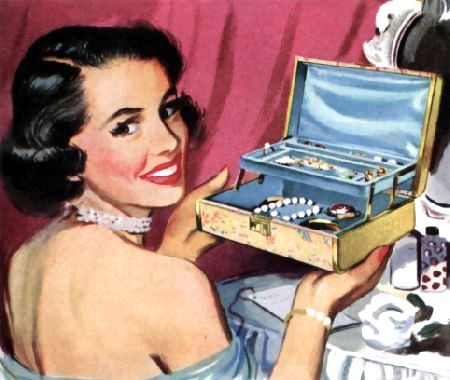
Elements of 1950’s Costume Jewelry
These tell-tale features can help you spot jewelry from this time period:
- Large, Chunky Pieces: Most of the costume jewelry from that time period was not super dainty. Look for statement pieces that are assembled with chunky plastic links and are in-your-face kitschy.
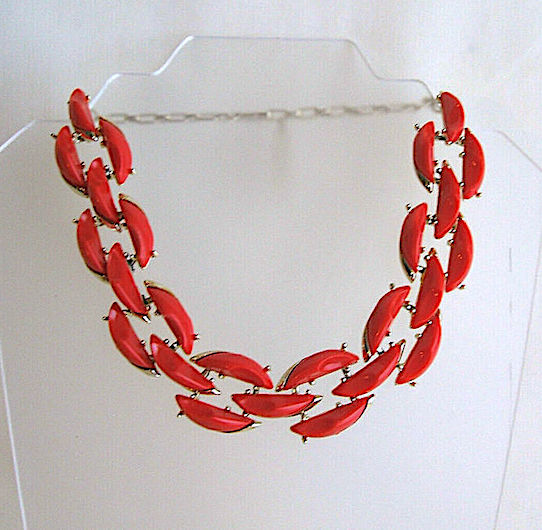
- Coated Settings: Much of the jewelry with thermoset elements was set in a frame with a metallic coating painted over it. This coating was either gold or silver.
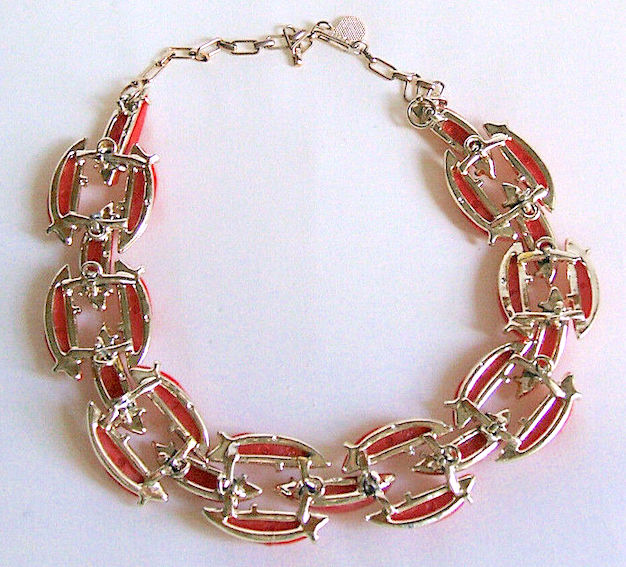
- Hook Closure: Here’s your tell-tale sign of mid century jewelry: the hook closure! These fishhook like clasps would hook onto either the chain or in between the beads of the chain at the back of the piece. C-clasps were usually used on bracelets, lobster claw and toggle clasps were not invented yet. Hook clasps might not stay on too well, but they help you identify the time period a necklace is from.


- Snake or Bar Chain: Some necklaces had either a snake chain (like the kind seen on small purses) or a bar chain which connected from the focal point of the piece to the clasp. These often had a ball affixed at the end.

- Thermoset Plastic: Thermoset is a hard plastic that was frequently used in jewelry in the 50’s. It’s sturdy and colorful which makes it ideal for costume pieces.

- Metal Structure: Much of the jewelry with rhinestones were designed with a large metal setting. The setting would sometimes be molded to look like leaves.
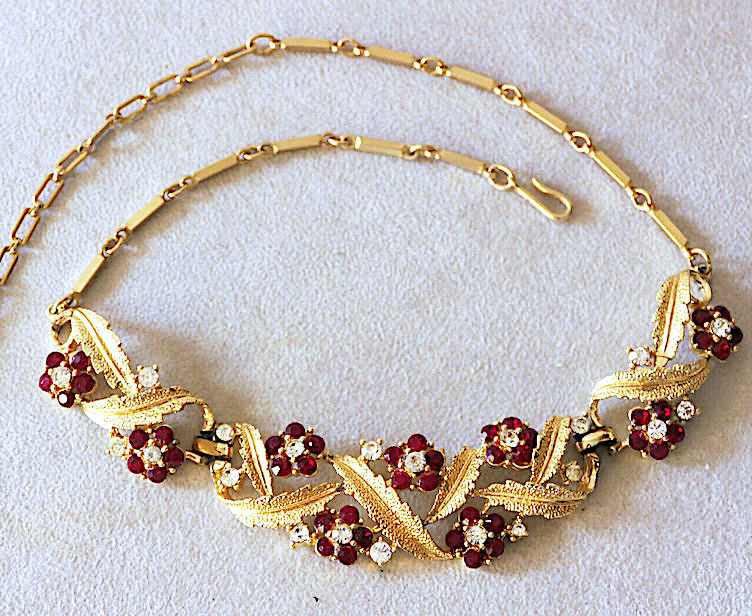
Costume Jewelry Types and Trends:
- Color: Color was beginning to emerge in costume jewelry in the 1950’s, replacing the clear rhinestones of the previous decade. One reason for this was that more and more films were being produced in Technicolor than ever before.
- Matching Sets: Both clothing and jewelry was known for its matching sets in the 50’s. Jewelry was often available in matching pieces or sold as a demi parure.
- Aurora Borealis: many of the rhinestones and molded glass elements were covered with a shimmery coating called “aurora borealis”. This coating would give glass stones a multi-colored shimmery effect, similar to its namesake.
- Rhinestones: Although kitschy plastics were all the rage, rhinestones were still very popular in the 50’s. They were used more as accents in pieces rather than the main feature, and many were covered with the “AB” (aurora borealis) coating.

- Accent Pearls: Many pieces included small, faux accent pearls in with the main design. Some would use several small pearls to make up the main design.
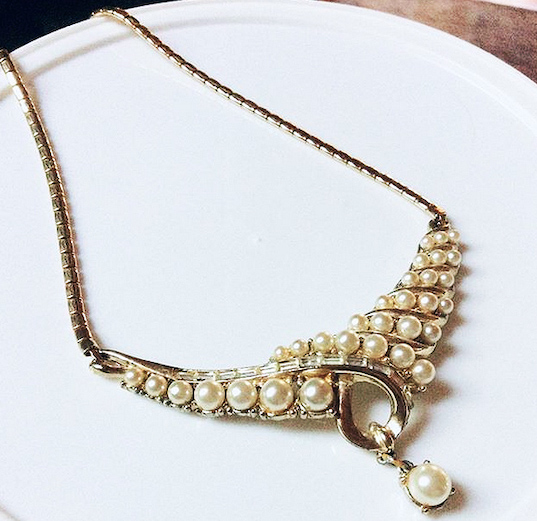
- Brooches: Brooches were very popular in the 1950’s! Many ladies would decorate the lapels of their coats with a big, fancy brooch.
- Pins: Smaller pins were worn too, but the tiny “scatter” pins were more popular later, in the early 1960’s.

- Charm Bracelets: Charm bracelets began their popularity in the 1950’s, but it was the 1960’s when the bracelets with several small add-on charms really took off. 1950’s charm bracelets usually featured a single, large charm hanging from a bracelet, such as Coro’s line of Birthstone bracelets:

- Confetti: Some lucite plastic jewelry was infused with iridescent confetti to give it a fun, shimmery effect. Necklaces, bracelets and earrings were all available with confetti elements. The confetti trend was so popular, that it was not just found in jewelry, but in make-up compacts, purses, sweater clips and even soap dishes!

- Moonglow: “Moonglow” jewelry was made from thermoset plastic which appeared to have a “glow” to it. This trend was available in the “Moonray” collection by Coro which featured necklaces, bracelets and earrings in several colors.

TRIVIA: Earrings in the 50’s had either clip-on or screw-on backings. Earrings back then were not made for pieced ears, because nobody had them! Women did not begin piercing their ears regularly until the 1970’s!
Popular Costume Jewelry Brands:
There were many companies that produced costume jewelry in the 1950’s, and most of them were in the United States. (Yes, the jewelry was actually made there too!) Here are a few popular brands for everyday women that were often advertised:
- Coro: Coro is my “go to” 1950’s brand when I want something affordable that is a good example of the era. Coro is known for its early Pegasus logo and its many different styles that were indicative of the mid-century era.
- Trifari: Like Coro, Trifari made many different styles that are today sought after by collectors. Trifari jewelry was a step above Coro in quality in most cases. Trifari is my personal favorite brand!
- Kramer: Kramer made mostly rhinestone jewelry, but also some plastic pieces.
- Leru: Leru made large, kitschy necklaces like the coral one above. They are also known for their travel charm bracelet.
- Lisner: Lisner is well known for their molded plastic elements, particularly leaves.
The ca. 1957 Trifari ad below features some of the plastics and enamel work that was popular at the time.

One of Trifari’s most sought-after and beautiful designs is called “Twinkle” and was offered in 1955. Even though plastics were trendy, rhinestones were still fairly popular throughout the decade. The picture below is of my set: Necklace, brooch and earrings!

In the ad below, on the top left and right sides, you can see the variations of the designs and metal color finish on “Twinkle”.

Where to Find Vintage Costume Jewelry:
You can find vintage jewelry in all the old familiar places: eBay, Etsy, vintage and antique shops, flea markets and estate sales. Here are my experiences with each:
- eBay: Good ole eBay. This is the best place to buy vintage jewelry IMO, because there is so much to choose from. Most common costume jewelry designs were made by the thousands, so there is no reason to pay high prices for them. eBay has both auctions and BIN where you can negotiate prices and get a decent deal on a lower end piece. And if you prefer to buy something rarer, or higher end, you have a lot of choices there too.
- Etsy: Etsy is a bit more expensive, since it’s set up like a boutique, but certainly you can find some great pieces there as well. I prefer Etsy when looking for a more special piece of jewelry, rather than a common one. The common ones are usually better priced on eBay.
- Vintage and Antique Shops: Bad deal. Unless you don’t care about how much you spend, I advise you avoid buying vintage jewelry in shops. Shop vendors act like every piece over 50 yrs old is super rare and the prices will reflect this. Unless, of course, they are having a clearance sale, in which case you might score a good find.
- Flea Markets: This used to be a great place to find vintage jewelry, but no more. Prices at flea markets these days are not much better than in the shops. Worse, stuff is sometimes in a big, knotted pile and when you ask how much a piece is, the answer you get is usually: “That’s from the 50’s” followed by a high price tag. On the other hand, you might find a seller who is trying to get rid of their stuff and will make you a deal especially if you purchase a bundle. AND don’t forget to factor in how much you’ll save on shipping if you make a purchase in person.
- Estate Sales: I personally have not had much luck with vintage jewelry at estate sales. The prices are usually better than in shops, but still usually too high for what the pieces are.
TIP: Beware of condition when you are buying vintage jewelry, especially online. Look at all photos, read descriptions and ask questions. Costume jewelry from the 1950’s can have issues with yellowing glue, peeling paint, flaking coating and darkening or loose stones. Make sure you know what you’re getting!
Recommended Reading:
It is impossible to cover everything about vintage costume jewelry in just one post. I highly recommend you read Julia C. Carroll’s books “Collecting Costume Jewelry”, especially the first book (101: Starting, Building and Upgrading) and second book (202: Dating Costume Jewelry). These will really help you identify costume jewelry by style, brand and time period!

***
Thank you for reading my post on Costume Jewelry of the 50’s! Stay tuned for more in Collecting 1950’s. You can follow Retro Dee’s Guide to the Best Era ever here on Word Press and you can also follow me on Twitter @RealRetroDee and for more pictures of my collections on Instagram @mariepascal82
Til then, stay glam!
❤
– dee
As always I do not get paid to endorse any products or companies.
Last revision: September 8, 2022

2 thoughts on “Collecting 1950’s: How to Identify 50’s Costume Jewelry”
Comments are closed.